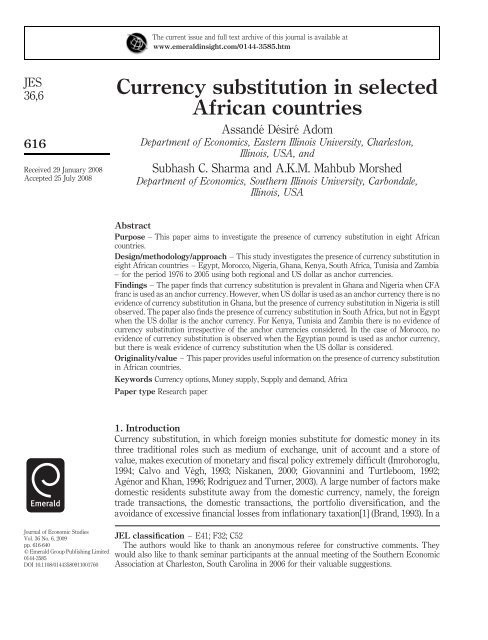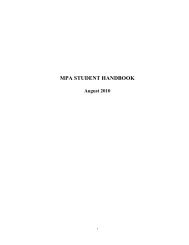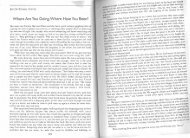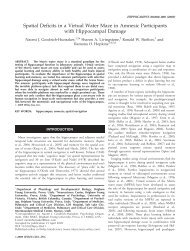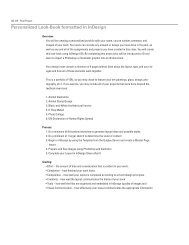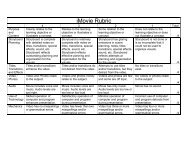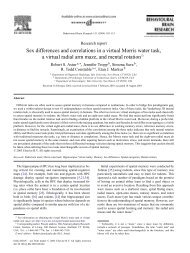Currency substitution in selected African countries - Emerald
Currency substitution in selected African countries - Emerald
Currency substitution in selected African countries - Emerald
Create successful ePaper yourself
Turn your PDF publications into a flip-book with our unique Google optimized e-Paper software.
The current issue and full text archive of this journal is available at<br />
www.emerald<strong>in</strong>sight.com/0144-3585.htm<br />
JES<br />
36,6<br />
616<br />
Received 29 January 2008<br />
Accepted 25 July 2008<br />
<strong>Currency</strong> <strong>substitution</strong> <strong>in</strong> <strong>selected</strong><br />
<strong>African</strong> <strong>countries</strong><br />
Assandé Désiré Adom<br />
Department of Economics, Eastern Ill<strong>in</strong>ois University, Charleston,<br />
Ill<strong>in</strong>ois, USA, and<br />
Subhash C. Sharma and A.K.M. Mahbub Morshed<br />
Department of Economics, Southern Ill<strong>in</strong>ois University, Carbondale,<br />
Ill<strong>in</strong>ois, USA<br />
Abstract<br />
Purpose – This paper aims to <strong>in</strong>vestigate the presence of currency <strong>substitution</strong> <strong>in</strong> eight <strong>African</strong><br />
<strong>countries</strong>.<br />
Design/methodology/approach – This study <strong>in</strong>vestigates the presence of currency <strong>substitution</strong> <strong>in</strong><br />
eight <strong>African</strong> <strong>countries</strong> – Egypt, Morocco, Nigeria, Ghana, Kenya, South Africa, Tunisia and Zambia<br />
– for the period 1976 to 2005 us<strong>in</strong>g both regional and US dollar as anchor currencies.<br />
F<strong>in</strong>d<strong>in</strong>gs – The paper f<strong>in</strong>ds that currency <strong>substitution</strong> is prevalent <strong>in</strong> Ghana and Nigeria when CFA<br />
franc is used as an anchor currency. However, when US dollar is used as an anchor currency there is no<br />
evidence of currency <strong>substitution</strong> <strong>in</strong> Ghana, but the presence of currency <strong>substitution</strong> <strong>in</strong> Nigeria is still<br />
observed. The paper also f<strong>in</strong>ds the presence of currency <strong>substitution</strong> <strong>in</strong> South Africa, but not <strong>in</strong> Egypt<br />
when the US dollar is the anchor currency. For Kenya, Tunisia and Zambia there is no evidence of<br />
currency <strong>substitution</strong> irrespective of the anchor currencies considered. In the case of Morocco, no<br />
evidence of currency <strong>substitution</strong> is observed when the Egyptian pound is used as anchor currency,<br />
but there is weak evidence of currency <strong>substitution</strong> when the US dollar is considered.<br />
Orig<strong>in</strong>ality/value – This paper provides useful <strong>in</strong>formation on the presence of currency <strong>substitution</strong><br />
<strong>in</strong> <strong>African</strong> <strong>countries</strong>.<br />
Keywords <strong>Currency</strong> options, Money supply, Supply and demand, Africa<br />
Paper type Research paper<br />
Journal of Economic Studies<br />
Vol. 36 No. 6, 2009<br />
pp. 616-640<br />
q <strong>Emerald</strong> Group Publish<strong>in</strong>g Limited<br />
0144-3585<br />
DOI 10.1108/01443580911001760<br />
1. Introduction<br />
<strong>Currency</strong> <strong>substitution</strong>, <strong>in</strong> which foreign monies substitute for domestic money <strong>in</strong> its<br />
three traditional roles such as medium of exchange, unit of account and a store of<br />
value, makes execution of monetary and fiscal policy extremely difficult (Imrohoroglu,<br />
1994; Calvo and Végh, 1993; Niskanen, 2000; Giovann<strong>in</strong>i and Turtleboom, 1992;<br />
Agénor and Khan, 1996; Rodriguez and Turner, 2003). A large number of factors make<br />
domestic residents substitute away from the domestic currency, namely, the foreign<br />
trade transactions, the domestic transactions, the portfolio diversification, and the<br />
avoidance of excessive f<strong>in</strong>ancial losses from <strong>in</strong>flationary taxation[1] (Brand, 1993). In a<br />
JEL classification – E41; F32; C52<br />
The authors would like to thank an anonymous referee for constructive comments. They<br />
would also like to thank sem<strong>in</strong>ar participants at the annual meet<strong>in</strong>g of the Southern Economic<br />
Association at Charleston, South Carol<strong>in</strong>a <strong>in</strong> 2006 for their valuable suggestions.
country where currency <strong>substitution</strong> is prevalent, <strong>in</strong>terest rate (both real and nom<strong>in</strong>al)<br />
changes would be uncerta<strong>in</strong> due to the <strong>in</strong>stability of the money demand.<br />
Researchers exam<strong>in</strong>ed the existence of currency <strong>substitution</strong>s and its adverse<br />
effects on policy mak<strong>in</strong>g for both developed and underdeveloped <strong>countries</strong>[2]. Three<br />
dist<strong>in</strong>ct methods are used to identify the presence of currency <strong>substitution</strong>. Thomas<br />
(1985) argued that the ratio of real domestic balances to real foreign balances should be<br />
negatively related to the domestic nom<strong>in</strong>al <strong>in</strong>terest rate and positively to the foreign<br />
nom<strong>in</strong>al <strong>in</strong>terest rate if currency <strong>substitution</strong> exists <strong>in</strong> those economies. Other<br />
researchers used optimiz<strong>in</strong>g framework with both domestic currency and foreign<br />
currency as assets to identify currency <strong>substitution</strong>s[3] (Selçuk, 2003; Agénor and<br />
Khan, 1996). The presence of currency <strong>substitution</strong> has been also tested by exam<strong>in</strong><strong>in</strong>g<br />
the stability of the money demand function as the presence of currency <strong>substitution</strong><br />
<strong>in</strong>creases the volatility of money demand (Darrat et al., 1996; Sharma et al., 2004).<br />
The latter approach is the one considered <strong>in</strong> this paper. It is an <strong>in</strong>direct way of<br />
<strong>in</strong>vestigat<strong>in</strong>g the existence of currency <strong>substitution</strong> <strong>in</strong> a country by pay<strong>in</strong>g attention to<br />
the changes that take place <strong>in</strong> the money demand for domestic currency. We consider<br />
this approach because the data on foreign monies circulat<strong>in</strong>g <strong>in</strong> the economy and<br />
foreign deposits of domestic residents are not available for the <strong>countries</strong> considered<br />
here. Moreover, this approach has an advantage because it accounts for both capital<br />
mobility and currency <strong>substitution</strong>. Recently, Prock et al. (2003) <strong>in</strong>vestigated the<br />
presence of currency <strong>substitution</strong> <strong>in</strong> Lat<strong>in</strong> America <strong>countries</strong> us<strong>in</strong>g this approach.<br />
They exam<strong>in</strong>ed the money demand function of Argent<strong>in</strong>a, Brazil and Mexico <strong>in</strong> a<br />
vector error correction model. Their f<strong>in</strong>d<strong>in</strong>gs <strong>in</strong>dicate that currency <strong>substitution</strong> is<br />
prevalent <strong>in</strong> all three <strong>countries</strong>, but it is more pronounced <strong>in</strong> Brazil and Argent<strong>in</strong>a than<br />
<strong>in</strong> Mexico. Also, Darrat et al. (1996) exam<strong>in</strong>ed the stability of money demand function<br />
for Japan while other researchers used a similar approach to study currency<br />
<strong>substitution</strong> <strong>in</strong> Asian develop<strong>in</strong>g <strong>countries</strong> (Sharma et al., 2004) and Mexico (Rodriguez<br />
and Turner, 2003).<br />
The stability of the money demand function is crucial to conduct an efficient and<br />
<strong>in</strong>dependent monetary policy. Haug and Lucas (1996) used a co-<strong>in</strong>tegration analysis to<br />
study the stability of the Canadian long-run money demand. They also estimated the<br />
parameters with the fully-modified estimation method us<strong>in</strong>g quarterly data from<br />
1953:1 to 1990:4, and observed a stable money demand function for Canada. Lutkepohl<br />
et al. (1999) studied the stability and l<strong>in</strong>earity of a German money (M1) demand<br />
function. They used smooth transition regression techniques capable of<br />
accommodat<strong>in</strong>g both smooth and sudden change <strong>in</strong> regression coefficients over<br />
time. Us<strong>in</strong>g quarterly data from 1960:1 to 1995:4, they noted that the relationship was<br />
l<strong>in</strong>ear and stable before 1990 and the monetary unification barely changed this<br />
relationship. Ibrahim (1998) us<strong>in</strong>g co-<strong>in</strong>tegration technique exam<strong>in</strong>ed the stability of<br />
money demand <strong>in</strong> Malaysia by consider<strong>in</strong>g both M1 and M2 and observed that M1 is<br />
unstable <strong>in</strong> the long run, while M2 is stable <strong>in</strong> the long-run but unstable <strong>in</strong> the<br />
short-run. Consequently, he concludes that us<strong>in</strong>g M2 as a target <strong>in</strong> monetary policy will<br />
be recommended provided that the policy makers figure out the structural break <strong>in</strong> the<br />
money demand. There are only few studies devoted to money demand <strong>in</strong> <strong>African</strong><br />
<strong>countries</strong> (for example see Agénor and Khan, 1996; Alami, 2001; and Elkhafif, 2003).<br />
Generally researchers exam<strong>in</strong>e whether currency <strong>substitution</strong> exists between<br />
domestic currency and US dollar, British pound, or Japanese yen. However, <strong>countries</strong><br />
<strong>Currency</strong><br />
<strong>substitution</strong><br />
617
JES<br />
36,6<br />
618<br />
with weaker trade ties to these rich <strong>countries</strong> along with underdeveloped foreign<br />
currency market might lead agents to substitute other regional currency that might<br />
make their money demand unstable. As <strong>African</strong> <strong>countries</strong> are mov<strong>in</strong>g towards a more<br />
market based monetary regimes, a crucial part of this framework is to understand the<br />
behavior of their money demand functions. But, only few studies have been devoted to<br />
<strong>in</strong>vestigate the money demand <strong>in</strong> <strong>African</strong> <strong>countries</strong>. Moreover, all these studies<br />
<strong>in</strong>vestigated the stability of money demand by us<strong>in</strong>g currency <strong>substitution</strong> between US<br />
dollar and domestic currency. In this paper, we <strong>in</strong>vestigate the existence of currency<br />
<strong>substitution</strong> <strong>in</strong> eight <strong>African</strong> <strong>countries</strong>: Ghana, Kenya, Tunisia, Zambia, South Africa,<br />
Morocco, Nigeria and Egypt by exam<strong>in</strong><strong>in</strong>g the stability of the money demand function<br />
<strong>in</strong> these <strong>countries</strong> us<strong>in</strong>g quarterly data from 1976:1 to 2005:4. Towards this goal both<br />
the US dollar and regional currencies are used as anchor currencies. We chose these<br />
eight <strong>African</strong> <strong>countries</strong> ma<strong>in</strong>ly for two reasons. We <strong>in</strong>tend to reexam<strong>in</strong>e us<strong>in</strong>g a<br />
different approach the f<strong>in</strong>d<strong>in</strong>gs of Agénor and Khan (1996) and Elkhafif (2003) who<br />
<strong>in</strong>cluded Egypt, Morocco, Nigeria and South Africa <strong>in</strong> their papers. We added four<br />
more <strong>countries</strong> (Ghana, Kenya, Tunisia and Zambia) s<strong>in</strong>ce these <strong>countries</strong> follow<br />
somewhat float<strong>in</strong>g exchange rate regimes and they have relatively stable political<br />
environment. Also, the availability of (reliable) data has been a factor <strong>in</strong> our choice for<br />
these <strong>countries</strong>.<br />
The extent of currency <strong>substitution</strong> could be determ<strong>in</strong>ed with precision if one could<br />
get data on the quantity of foreign money with the public, the quantity of foreign<br />
money deposits <strong>in</strong> the domestic bank<strong>in</strong>g system and the amount of foreign currency<br />
deposits made abroad by domestic residents. However, the data on quantity of foreign<br />
money <strong>in</strong> circulation are not available even <strong>in</strong> developed <strong>countries</strong>. So applied<br />
researchers commonly use proxies like expected change <strong>in</strong> depreciation of exchange<br />
rate to circumvent the data problem (see Prock et al., 2003; Elkhafif, 2003).<br />
Our results <strong>in</strong>dicate that there is no evidence of currency <strong>substitution</strong> <strong>in</strong> Kenya,<br />
Tunisia, and Zambia for both US dollar and regional currencies. However, for Ghana<br />
we observe that people substitute for CFA franc for their currency but not the US<br />
dollar. This means that if we take <strong>in</strong>to account only the US dollar to exam<strong>in</strong>e the<br />
currency <strong>substitution</strong> we would have missed the presence of currency <strong>substitution</strong> <strong>in</strong><br />
Ghana. We also note that Nigerians substitute both the US dollar and the CFA franc for<br />
their currency. This is quite possible s<strong>in</strong>ce the rate of <strong>in</strong>flation <strong>in</strong> Nigeria is about 25<br />
percent, so <strong>in</strong> order to protect the value of their liquidity Nigerians opted for<br />
substitut<strong>in</strong>g for foreign currencies. In Egypt and South Africa, we observe no evidence<br />
of currency <strong>substitution</strong> with respect to the US dollar. Morocco yields currency<br />
<strong>substitution</strong> when the US dollar serves as anchor, but it is <strong>in</strong>significant. On the other<br />
hand, when the Egyptian pound is used as anchor currency, Morocco yields no<br />
evidence of currency <strong>substitution</strong>.<br />
This paper is structured as follows. In section 2 we specify the model. Data<br />
descriptions are presented <strong>in</strong> section 3, while the results and the policy implications are<br />
discussed <strong>in</strong> section 4. At the end some conclud<strong>in</strong>g remarks are made.<br />
2. Monetary policies <strong>in</strong> Africa<br />
<strong>African</strong> <strong>countries</strong> have adopted different monetary policies depend<strong>in</strong>g on whether or<br />
not a country was colonized by France or Great Brita<strong>in</strong>. Honohan and O’Connell (1997)<br />
have identified five types of monetary regimes adopted by <strong>countries</strong> across Africa
s<strong>in</strong>ce the 1960s. First, we have a rule-based regime. The currency board system is<br />
def<strong>in</strong>ed as a set of rules prevent<strong>in</strong>g the exercise of discretion <strong>in</strong> most dimensions of<br />
central bank activity (see Honohan and O’Connell, 1997). For <strong>in</strong>stance, <strong>in</strong> most of the<br />
British colonies (Ghana, Kenya, Nigeria, Zambia, among others) this system prevailed<br />
throughout the 1960s. On the other hand, <strong>in</strong> the French colonies (Ben<strong>in</strong>, Côte d’Ivoire,<br />
Senegal, Central <strong>African</strong> Republic, Burk<strong>in</strong>a Faso, among others) a rule-based system<br />
with much more control from France was implemented. It simply pegged local<br />
currencies to the French national currency (the French franc). As a result, monetary<br />
policies of these <strong>countries</strong> were almost entirely conducted by proxy by France<br />
throughout the 1960s to the 1990s. Recently, these <strong>countries</strong> are conduct<strong>in</strong>g somewhat<br />
more <strong>in</strong>dependent monetary policies.<br />
The second form of monetary regime is the automatic monetary f<strong>in</strong>anc<strong>in</strong>g system.<br />
In this system, authorities make extensive use of deficit f<strong>in</strong>anc<strong>in</strong>g by issu<strong>in</strong>g<br />
high-powered money to accommodate any macroeconomic shock. Fiscal deficits for<br />
<strong>in</strong>stance are essentially f<strong>in</strong>anced through <strong>in</strong>flation tax. Countries like Liberia, Sierra<br />
Leone, Somalia and Zambia (<strong>in</strong> the 1980s, 1990s); Angola (<strong>in</strong> the 1990s) and Democratic<br />
Republic of Congo (from the 1970s to the 1990s) fit <strong>in</strong> this category. In other words, the<br />
quest for a controlled <strong>in</strong>flation is not a key objective of monetary decision-makers <strong>in</strong><br />
these <strong>countries</strong>. As a result, these <strong>countries</strong> have experienced persistent <strong>in</strong>flation, or<br />
even hyper<strong>in</strong>flation.<br />
Third, there is the controlled economy regime or ration<strong>in</strong>g regime. In these regimes,<br />
goods and exchange rates are rationed mean<strong>in</strong>g that prices and quantities cannot<br />
fluctuate to clear markets. Authorities keep a tight control over the money supply. All<br />
shocks are accommodated through the establishment of rations. Thus, monetary policy<br />
<strong>in</strong> these economies is almost entirely passive or <strong>in</strong>active. Ghana, Tanzania and Uganda<br />
among others implemented such regime <strong>in</strong> the 1970s; while other <strong>countries</strong> like Angola<br />
and Mozambique among others used it for a longer period throughout the 1970s and<br />
1980s.<br />
Fourth, there is the monetary arrangement with credit ceil<strong>in</strong>g. In this regime,<br />
commercial banks are limited <strong>in</strong> their ability to create money by the monetary<br />
authorities. Many <strong>African</strong> <strong>countries</strong> have <strong>in</strong>troduced this form of monetary<br />
arrangement start<strong>in</strong>g <strong>in</strong> the 1980s (see for <strong>in</strong>stance Killick and Mwega, 1990).<br />
Ethiopia, Malawi and Nigeria have had a monetary policy driven by credit ceil<strong>in</strong>g from<br />
the 1970s to the 1980s. Others like Kenya, Zambia and Ghana among others have used<br />
this regime <strong>in</strong> the 1970s and 1980s, respectively.<br />
F<strong>in</strong>ally, we have market-clear<strong>in</strong>g regimes. In these regimes, most of the decisions<br />
made by monetary authorities f<strong>in</strong>d their rationales through the forces of markets. They<br />
enjoy much more <strong>in</strong>dependence vis-à-vis the government and <strong>in</strong> the implementation of<br />
their policies. The government itself barely relies on expansionary monetary policies to<br />
offset the fiscal deficit. There is no preset credit ceil<strong>in</strong>g as <strong>in</strong> the previous monetary<br />
arrangement: markets’ conditions dictate the creation of money by banks. This form of<br />
regime is not currently widely observed <strong>in</strong> Africa. However, as more and more <strong>African</strong><br />
governments are becom<strong>in</strong>g fiscally responsible and embrac<strong>in</strong>g the rules of good<br />
governance, we are witness<strong>in</strong>g a movement towards the establishment of <strong>in</strong>dependent<br />
central banks able to implement <strong>in</strong>dependent and market-based monetary policies. For<br />
example, Kenya has been implement<strong>in</strong>g a market clear<strong>in</strong>g approach s<strong>in</strong>ce the 1980s<br />
and Ghana started <strong>in</strong> the 1990s.<br />
<strong>Currency</strong><br />
<strong>substitution</strong><br />
619
JES<br />
36,6<br />
620<br />
3. Model specification and methodology<br />
3.1 Model specification<br />
Bahamani-Oskooee and Techaratanachai (2001) note that most of the money demand<br />
functions present two basic characteristics. On the one hand, the broader def<strong>in</strong>ition of<br />
money (M2) is considered <strong>in</strong>stead of M1, while exchange rate is <strong>in</strong>cluded as a<br />
determ<strong>in</strong>ant of money hold<strong>in</strong>g besides <strong>in</strong>come and the <strong>in</strong>terest rate. With this fact <strong>in</strong><br />
m<strong>in</strong>d, we use a portfolio-balance model where agents <strong>in</strong> a given country may hold four<br />
types of assets: domestic currency, foreign currency, domestic bonds and foreign<br />
bonds. We note that the <strong>African</strong> <strong>countries</strong> considered <strong>in</strong> this study have an<br />
<strong>in</strong>significant securities market and these markets, when they exist, are accessible to a<br />
few f<strong>in</strong>ancial <strong>in</strong>stitutions. Moreover, the issuance of bonds is not the primary channel<br />
for the governments to raise funds. Consequently, this study does not focus on<br />
domestic and foreign bonds equations that are overlooked <strong>in</strong> the portfolio. Money<br />
demand would depend on overall economic activities and also on the returns of the<br />
assets above.<br />
Us<strong>in</strong>g a modified version of Darrat et al. (1996), we specify the follow<strong>in</strong>g model:<br />
<br />
M D <br />
<br />
¼ f y; i; i * ; p e ; De e ; ð1Þ<br />
P<br />
where is domestic real money demand, y is <strong>in</strong>come, i is the domestic nom<strong>in</strong>al <strong>in</strong>terest<br />
rate, i * is the foreign <strong>in</strong>terest rate, p e is the expected rate of <strong>in</strong>flation and De e is the<br />
expected change <strong>in</strong> the exchange rate.<br />
As expected, <strong>in</strong>come y represents a key determ<strong>in</strong>ant of real money demand <strong>in</strong> most<br />
of <strong>African</strong> <strong>countries</strong> s<strong>in</strong>ce the average household ma<strong>in</strong>ta<strong>in</strong>s a sizeable amount of<br />
domestic balances to pay for day-to-day expenses. Alternative <strong>in</strong>struments of<br />
payments such as checks are not very well developed as a few households have bank<br />
accounts. Moreover, distrust <strong>in</strong> these <strong>in</strong>struments has <strong>in</strong>creased the reluctance of<br />
people to use them s<strong>in</strong>ce many checks turn out to be fake or unfunded[4]. As a result,<br />
we expect the partial derivative of real money balances with respect to transactions to<br />
be positive.<br />
Despite the non-existence of well-developed f<strong>in</strong>ancial markets, both nom<strong>in</strong>al and<br />
foreign <strong>in</strong>terest rates play a noticeable role <strong>in</strong> <strong>African</strong> <strong>countries</strong> <strong>in</strong> the determ<strong>in</strong>ation of<br />
domestic balances for ma<strong>in</strong>ly two reasons. First, notwithstand<strong>in</strong>g the fact that lots of<br />
households have little knowledge of the function<strong>in</strong>g of f<strong>in</strong>ancial markets <strong>in</strong> terms of the<br />
opportunity cost for hold<strong>in</strong>g money, more and more educated people along with their<br />
<strong>in</strong>volvement <strong>in</strong> the economic activities have come to understand the benefits for<br />
open<strong>in</strong>g a sav<strong>in</strong>g or some sort of term accounts that bear <strong>in</strong>terest.<br />
The second reason is that many medium and big size corporations which represent<br />
a substantial part of the demand for domestic real balances are now extend<strong>in</strong>g their<br />
activities across borders to take advantage of the many opportunities available due to<br />
the proximity of important markets such as the WAEMU[5] <strong>countries</strong> for Ghana and<br />
Nigeria, the South <strong>African</strong> economy for Kenya and Zambia, and the Egyptian economy<br />
for Morocco and Tunisia. As nom<strong>in</strong>al <strong>in</strong>terest rates are <strong>in</strong>creas<strong>in</strong>g, people will hold<br />
fewer domestic currency thereby decrease their demand for domestic real money.<br />
Thus, the expected signs of i is negative.
Inflationary expectations (p e ) rema<strong>in</strong> a key determ<strong>in</strong>ant of the quantity of real<br />
domestic balances as it erodes the value of nom<strong>in</strong>al money hold<strong>in</strong>g. However, the<br />
source of this <strong>in</strong>flationary expectation is crucial for the relationship between<br />
<strong>in</strong>flationary expectation and money demand. The sign of the derivative of real money<br />
balances with respect to expected <strong>in</strong>flation would be negative if the expectation for an<br />
<strong>in</strong>crease <strong>in</strong> prices is due to pure economic reasons. But if the dom<strong>in</strong>ant factor beh<strong>in</strong>d<br />
<strong>in</strong>flationary expectation is the political and social <strong>in</strong>stability, we might observe a<br />
positive relationship between p e and money demand. As a matter of fact, dur<strong>in</strong>g<br />
political <strong>in</strong>stability of uncerta<strong>in</strong> duration, the cha<strong>in</strong> of supply of goods and services is<br />
either broken or weakened lead<strong>in</strong>g to a shortage and, ultimately, to a price <strong>in</strong>crease.<br />
Also, people are aware of the fact that depository <strong>in</strong>stitutions (banks) will rema<strong>in</strong> close<br />
dur<strong>in</strong>g these times of <strong>in</strong>stabilities and also people want to protect their un<strong>in</strong>terrupted<br />
consumption level. Thus we expect the coefficient of p e to be positive.<br />
We can rewrite the money demand function, i.e. equation (1), <strong>in</strong> the follow<strong>in</strong>g<br />
l<strong>in</strong>earized form:<br />
<strong>Currency</strong><br />
<strong>substitution</strong><br />
621<br />
<br />
M D<br />
¼ l 0 þ l 1 y t þ l 2 i þ l 3 i * þ l 4 p e þ l 5 De e ð2Þ<br />
P<br />
where, l 1 . 0 and l 2 , l 3 , l 4 , l 5 , 0. Equation (2) is used for each country.<br />
The real return of foreign bonds (essentially government’s bond) also determ<strong>in</strong>es<br />
the demand for real balances as it is another compet<strong>in</strong>g asset. The expected ga<strong>in</strong>s <strong>in</strong><br />
exchange rate differential will add to the nom<strong>in</strong>al return that will be received on a<br />
given foreign bond or <strong>in</strong>terest bear<strong>in</strong>g asset. That is, the real return on foreign bonds is<br />
the sum of i * and the expected change <strong>in</strong> the exchange rate De e .Thus, follow<strong>in</strong>g the<br />
previous research and us<strong>in</strong>g (i * þ De e ) for i * <strong>in</strong> equation (2), we obta<strong>in</strong>:<br />
<br />
M D <br />
¼ l 0 þ l 1 y t þ l 2 i þ l 3 i * þ De e þ l 4 p e þ l 5 De e :<br />
P<br />
ð3Þ<br />
Moreover, there is a consensus <strong>in</strong> the literature concern<strong>in</strong>g the fact that, with an<br />
<strong>in</strong>creas<strong>in</strong>gly <strong>in</strong>tegrated world coupled with a great deal of liberalization of both<br />
f<strong>in</strong>ancial and goods markets, <strong>in</strong>terest rates (foreign and domestic) vary to equalize each<br />
other[6]. This idea is well documented <strong>in</strong> Giddy (1993), Madura (1992), Francis et al.<br />
(2002) and Drakos (2003) <strong>in</strong> the context of develop<strong>in</strong>g <strong>countries</strong> and is known <strong>in</strong> the<br />
literature as the <strong>in</strong>terest rate parity argument. This equilibrium condition implies that:<br />
<br />
i ¼ i * þ De e : ð4Þ<br />
Thus, the f<strong>in</strong>al form of the money demand function can be expressed <strong>in</strong> equation (5):<br />
<br />
M D<br />
¼ g 0 þ g 1 y t þ g 2 i t þ g 3 p e t<br />
P<br />
þ g 4De e t :<br />
ð5Þ<br />
t<br />
Equation (5) has a dist<strong>in</strong>ct advantage as we now excluded the foreign <strong>in</strong>terest rate as a<br />
determ<strong>in</strong>ant of the domestic real money demand. This is good for model<strong>in</strong>g money<br />
demand for <strong>African</strong> <strong>countries</strong> as <strong>in</strong>formation on foreign <strong>in</strong>terest is not widely available.
JES<br />
36,6<br />
622<br />
The expected change <strong>in</strong> exchange rate (De e ) is used to identify the existence of<br />
currency <strong>substitution</strong> <strong>in</strong> this paper. A few studies conducted for <strong>African</strong> <strong>countries</strong><br />
(Elkhafif, 2003; Agénor and Khan, 1996) essentially consider the US dollar as anchor<br />
currency. The present study departs from this approach by consider<strong>in</strong>g stable<br />
currencies of Africa such as the CFA[7] franc as anchor <strong>in</strong> West Africa for Ghana and<br />
Nigeria; the South <strong>African</strong> Rand for Kenya and Zambia; the Egyptian pound for<br />
Morocco and Tunisia <strong>in</strong> Northern Africa. This approach is realistic because of the<br />
proximity of these blocs of <strong>countries</strong> with respect to the anchor currency economy due<br />
to the convenience for domestic agents and the <strong>in</strong>creas<strong>in</strong>g level of exchanges that are<br />
be<strong>in</strong>g conducted among these <strong>countries</strong>. F<strong>in</strong>ally, the US dollar is used as anchor for<br />
Egypt and South Africa as they serve themselves as anchor for other <strong>countries</strong>. A<br />
significant negative coefficient of the expected fluctuations <strong>in</strong> exchange rates will<br />
identify the existence of currency <strong>substitution</strong> (Bordo and Choudhri, 1982). As a matter<br />
of fact, a negative sign associated with expected changes <strong>in</strong> exchange rates will<br />
<strong>in</strong>dicate that economic agents are reduc<strong>in</strong>g their hold<strong>in</strong>g of real domestic balances as a<br />
depreciation of the domestic currency is anticipated. In other words, they shy away<br />
from the domestic currency and substitute it with the anchor currency that is<br />
appreciat<strong>in</strong>g. People adjust their hold<strong>in</strong>gs of real domestic balances by substitut<strong>in</strong>g<br />
foreign currency (the anchor currency) for domestic currency as the domestic currency<br />
is expected to depreciate. We will estimate equation (6) for each of these <strong>African</strong><br />
<strong>countries</strong>. A negative and significant g 4 will <strong>in</strong>dicate the presence of currency<br />
<strong>substitution</strong> <strong>in</strong> a country.<br />
3.2 Data<br />
We collected quarterly data for Egypt, Ghana, Kenya, Morocco, Nigeria, South Africa,<br />
Tunisia, and Zambia for the period 1976 to 2005 from the International F<strong>in</strong>ancial<br />
Statistics (IFS) published by the IMF. We considered this time period as<br />
float<strong>in</strong>g/managed float<strong>in</strong>g exchange rate regimes <strong>in</strong> these <strong>countries</strong> would allow us<br />
to identify currency <strong>substitution</strong> by exam<strong>in</strong><strong>in</strong>g the stability of the money demand<br />
function us<strong>in</strong>g expected depreciation of the exchange rate as a proxy. For each country,<br />
we collected data on the domestic real money demand(M2/P)[8]; the real gross national<br />
<strong>in</strong>come ( y); the domestic deposit <strong>in</strong>terest rate (i ); expected <strong>in</strong>flation rate, p e , measured<br />
by the change <strong>in</strong> the actual rate of <strong>in</strong>flation, i.e. Dp; and the expected depreciation <strong>in</strong><br />
the exchange rate with respect to the anchor country approximated by the <strong>in</strong>flation<br />
differential between the domestic country considered and the anchor currency country.<br />
This also allows us to avoid econometric problems related to pegged and managed<br />
exchange rates.<br />
4. Results and policy implications<br />
Most of the studies <strong>in</strong> currency <strong>substitution</strong> exam<strong>in</strong>e whether people <strong>in</strong> a country hold<br />
foreign currencies of developed <strong>countries</strong> like US dollar, British pound, or Japanese<br />
yen. However, we exam<strong>in</strong>e whether people of these <strong>African</strong> <strong>countries</strong> hold some<br />
regional currencies. In addition to this, we exam<strong>in</strong>e whether they hold US dollar <strong>in</strong> their<br />
portfolio. The home currency and anchor currencies for each country are reported <strong>in</strong><br />
Table I.
4.1 Long-run analysis<br />
Prior to the estimation of model (5), we need to check the stationarity of each series<br />
used here. Thus, to test whether the series are stationary or not a variety of unit root<br />
tests are performed. We use Dickey-Fuller tests, Augmented Dickey-Fuller and<br />
different variations of Phillips-Perron tests on level and first difference for each series.<br />
We f<strong>in</strong>d that we have a comb<strong>in</strong>ation of I(0) and I(1) variables <strong>in</strong> the money demand<br />
equation of each country. For Egypt, ln(m 2 ), i, and Dp * are I(1) whereas ln ( y) and Dp<br />
are I(0). For Ghana, ln (m 2 ), ln ( y), i and Dp * are I(1), and Dp is I(0); for Kenya,<br />
Morocco, South Africa and Tunisia, ln(m 2 ), ln( y), i and Dp * are I(1) while Dp is I(0);<br />
and for Nigeria and Zambia ln(m 2 ), ln( y), i, Dp and Dp * are all I(1)[9].<br />
We <strong>in</strong>vestigate the existence of a long-run relationship between real money<br />
balances, real <strong>in</strong>come, <strong>in</strong>terest rate, expected <strong>in</strong>flation and expected exchange rate<br />
depreciation. In Table II, we report the l-max and l-trace statistics proposed by<br />
<strong>Currency</strong><br />
<strong>substitution</strong><br />
623<br />
Country Home currency Anchor currency<br />
Egypt Pound US dollar<br />
Ghana New Cedi CFA franc<br />
Kenya Shill<strong>in</strong>g South Africa rand<br />
Morocco Dirham Egyptian pound<br />
Nigeria Naira CFA franc<br />
South Africa Rand US dollar<br />
Tunisia D<strong>in</strong>ar Egyptian pound<br />
Zambia Kwacha South Africa rand<br />
Table I.<br />
Home and anchor<br />
currencies<br />
Number of co<strong>in</strong>tegrat<strong>in</strong>g vectors<br />
Country Test statistic r # 0 r # 1 r # 2 r # 3 r # 4<br />
Egypt l-trace 154.636 75.076 33.712 10.981 0.155<br />
p ¼ 3 l-max 79.559 41.364 22.731 10.826 0.155<br />
Ghana l-trace 137.066 67.053 31.288 11.471 5.148<br />
p ¼ 3 l-max 70.012 35.766 19.817 6.323 5.148<br />
Kenya l-trace 93.469 60.590 31.256 8.971 1.297<br />
p ¼ 8 l-max 32.879 29.333 22.285 7.675 1.297<br />
Morocco l-trace 104.981 48.127 20.219 9.192 0.313<br />
p ¼ 4 l-max 56.854 27.908 11.027 8.879 0.313<br />
Nigeria l-trace 113.281 64.735 21.436 9.538 0.396<br />
p ¼ 5 l-max 48.546 43.299 11.897 9.142 0.396<br />
South Africa * l-trace 143.383 91.202 51.524 31.185 11.725<br />
p ¼ 8 l-max 52.181 39.678 20.339 19.461 11.725<br />
Tunisia l-trace 79.689 41.806 13.873 4.283 1.479<br />
p ¼ 3 l-max 37.882 27.933 9.590 2.804 1.479<br />
Zambia l-trace 116.707 44.664 16.492 3.815 0.478<br />
p ¼ 3 l-max 72.042 28.172 12.677 3.337 0.478<br />
5 percent critical values: l-trace 69.819 47.856 29.797 15.495 3.841<br />
l-max 33.877 27.584 21.132 14.265 3.841<br />
5 percent critical values * l-trace 88.804 63.876 42.915 25.872 12.518<br />
l-max 38.331 32.118 25.823 19.387 12.518<br />
Note: p is the number of lags suggested by AIC<br />
Table II.<br />
l-trace and l-max test<br />
statistics
JES<br />
36,6<br />
624<br />
Johansen and Juselius (1990) to test for co-<strong>in</strong>tegration <strong>in</strong> all eight <strong>countries</strong>. The<br />
existence of at least one co-<strong>in</strong>tegration vector suggests that the variables considered<br />
move towards an equilibrium <strong>in</strong> the long-run. Both l-trace and l-max test statistics<br />
reveal that there are two co-<strong>in</strong>tegrat<strong>in</strong>g vectors <strong>in</strong> the case of Morocco and Nigeria and<br />
three and four co-<strong>in</strong>tegrat<strong>in</strong>g vectors for Egypt and South Africa, respectively. As a<br />
matter of fact, l-max <strong>in</strong>dicates two co-<strong>in</strong>tegrat<strong>in</strong>g vectors <strong>in</strong> the case of Ghana, Tunisia<br />
and Zambia, whereas l-trace <strong>in</strong>dicates just one co-<strong>in</strong>tegrat<strong>in</strong>g vector for Tunisia and<br />
Zambia, and three co-<strong>in</strong>tegrat<strong>in</strong>g vectors for Ghana. As far as Kenya is concerned,<br />
l-trace <strong>in</strong>dicates three co-<strong>in</strong>tegrat<strong>in</strong>g vectors, when l-max <strong>in</strong>dicates no co-<strong>in</strong>tegrat<strong>in</strong>g<br />
vector. However, for all <strong>countries</strong> there exists at least one co-<strong>in</strong>tegrat<strong>in</strong>g vector which<br />
<strong>in</strong> turn means that the relationship between money demand and its determ<strong>in</strong>ants holds<br />
<strong>in</strong> the long-run. Intercepts is tested <strong>in</strong> each co-<strong>in</strong>tegrat<strong>in</strong>g vector by us<strong>in</strong>g the likelihood<br />
ratio statistics[10]. Except for Egypt <strong>in</strong>tercept is significant for all <strong>countries</strong>.<br />
These results validate our model <strong>in</strong> equation (5). We then exam<strong>in</strong>e the significance<br />
levels of these coefficients. A significant coefficient of the expected exchange rate<br />
depreciations <strong>in</strong> co-<strong>in</strong>tegrat<strong>in</strong>g vectors <strong>in</strong>dicates the <strong>in</strong>stability of the money demand<br />
function and the existence of currency <strong>substitution</strong>. The normalized co-<strong>in</strong>tegrat<strong>in</strong>g<br />
vector with the highest eigenvalue is discussed next for each country.<br />
4.1.1 Egypt. The normalized co-<strong>in</strong>tegrat<strong>in</strong>g vector correspond<strong>in</strong>g to the highest<br />
eigenvalue is:<br />
m 2 ¼<br />
1:858y t þ 0:049i t þ 0:118p e t þ 0:032De e t<br />
<br />
33:93 * 6:33 * 4:33 * 10:57 * :<br />
We f<strong>in</strong>d no evidence of currency <strong>substitution</strong> with respect to the US dollar as g 4 is<br />
positive and highly significant[11]. These f<strong>in</strong>d<strong>in</strong>gs suggest that real money demand <strong>in</strong><br />
Egypt is stable. This is contrary to the f<strong>in</strong>d<strong>in</strong>gs of Elkhafif (2003) who f<strong>in</strong>ds support<strong>in</strong>g<br />
evidence of currency <strong>substitution</strong> <strong>in</strong> Egypt us<strong>in</strong>g an error-correction model. In his<br />
work, currency <strong>substitution</strong> is approximated by the ratio of foreign currency deposits<br />
<strong>in</strong> commercial banks over money supply. The difference <strong>in</strong> his and this study may<br />
come from the fact that Elkhafif (2003) consider annual data for a shorter period from<br />
1991 to 2001. Indeed, dur<strong>in</strong>g this period Egypt experienced an <strong>in</strong>crease <strong>in</strong> foreign<br />
currency deposits <strong>in</strong>to her bank<strong>in</strong>g system, which could expla<strong>in</strong> why he f<strong>in</strong>ds strong<br />
evidence of currency <strong>substitution</strong>.<br />
To further our understand<strong>in</strong>g of the money demand function <strong>in</strong> Egypt, we derive<br />
the impulse response functions (IRFs) (IRFs for all <strong>countries</strong> are reported <strong>in</strong> Table III)<br />
and the variance decomposition functions (VDF)(VD results are reported <strong>in</strong> Table IV).<br />
In Figure 1, results <strong>in</strong>dicate that <strong>in</strong>novations <strong>in</strong> deposit rate have a positive impact on<br />
the real money balances. This impact decreases throughout the 15th period where it<br />
rema<strong>in</strong>s constant until the 40th period. Similarly, <strong>in</strong>novations <strong>in</strong> expected changes <strong>in</strong><br />
the exchange rates have a long-term positive effect on the real money demand and it<br />
rema<strong>in</strong>s persistent until the 40th period. Also, shocks <strong>in</strong> expected change <strong>in</strong> exchange<br />
rates are positive but rema<strong>in</strong> negligible and rema<strong>in</strong> smaller than the effects of<br />
<strong>in</strong>novations <strong>in</strong> money demand and real output. Shocks to domestic deposit rate are<br />
<strong>in</strong>itially positive until the 15th period before becom<strong>in</strong>g negative for the rema<strong>in</strong><strong>in</strong>g of<br />
the periods. Disturbances <strong>in</strong> expected <strong>in</strong>flation essentially have negative effects on
Variables<br />
Countries m 2 y i p e De e<br />
Ghana 1 27.679 0.0990 27.5440 20.1884<br />
(244.01 * )<br />
Kenya 1 28.565 0.0541 5.1068 20.0519<br />
(1.75)<br />
Morocco 1 22.587 20.0213 1.0314 0.0576<br />
(1.75)<br />
Nigeria 1 20.033 20.0468 0.8697 0.0314<br />
(4.86 * )<br />
Tunisia 1 20.435 1.1058 23.9735 20.0157<br />
(20.24)<br />
Zambia 1 27.167 0.0100 0.0157 20.0043<br />
(21.49)<br />
Notes: The anchor currency is US dollar; for consistency <strong>in</strong> our results and analysis, we follow the<br />
same specifications as those used <strong>in</strong> determ<strong>in</strong><strong>in</strong>g the number of co<strong>in</strong>tegrat<strong>in</strong>g vectors. To save space,<br />
we have reported vectors that make economic sense; * denotes significance at the 5 percent level<br />
<strong>Currency</strong><br />
<strong>substitution</strong><br />
625<br />
Table III.<br />
Normalized co<strong>in</strong>tegrat<strong>in</strong>g<br />
vectors<br />
money demand. These effects persist although with a low <strong>in</strong>tensity. In addition, all<br />
these responses are with<strong>in</strong> a 95 percent confidence <strong>in</strong>terval. This <strong>in</strong>dicates that our<br />
model performs well <strong>in</strong> describ<strong>in</strong>g the behavior the real money demand function. On<br />
the other hand, the VDF show that the variations <strong>in</strong> the domestic real balances are<br />
essentially determ<strong>in</strong>ed by fluctuations <strong>in</strong> real output that accounts for about 60 percent<br />
of variations <strong>in</strong> real demand. Consequently, we believe that Egypt should design her<br />
monetary policy focus<strong>in</strong>g ma<strong>in</strong>ly on domestic factors such as real output.<br />
4.1.2 Ghana. The model for Ghana is given by:<br />
0:010 þ 0:909y t 2 0:027i t 2 0:430p e t 2 0:119De e t<br />
<br />
m 2 ¼<br />
ð0:004Þ ð0:62Þ ð20:71Þ 24:78 * 26:83 * :<br />
We note that the coefficient for expected depreciation of exchange rate is negative and<br />
highly significant. This <strong>in</strong>dicates currency <strong>substitution</strong> between the Ghanaian Cedi<br />
and the CFA franc, which has effects on the money demand function. Monetary<br />
authorities cannot operate an <strong>in</strong>dependent monetary policy as external variables have<br />
significant <strong>in</strong>fluence on the money demand. Therefore, they should implement policies<br />
that take <strong>in</strong>to account evolution <strong>in</strong>to economies of <strong>countries</strong> us<strong>in</strong>g the CFA franc.<br />
People of Ghana f<strong>in</strong>d the use the CFA franc <strong>in</strong> conduct<strong>in</strong>g their transactions profitable.<br />
This is probably due to the fact that Ghana has borders with the CFA franc <strong>countries</strong>.<br />
Also the average <strong>in</strong>flation of 35 percent <strong>in</strong> Ghana would encourage people to hold a<br />
more stable currency. Bank of Ghana should ensure that domestic <strong>in</strong>flation does not<br />
diverge a great deal from the <strong>in</strong>flation rate of economies us<strong>in</strong>g the CFA franc.<br />
Moreover, IRFs <strong>in</strong> Figure 2 reveal that <strong>in</strong>novations <strong>in</strong> expected <strong>in</strong>flation and<br />
expected change <strong>in</strong> exchange rate create a negative and persistent effect on money<br />
demand throughout from the short-run till the long-run. Innovations <strong>in</strong> both real output<br />
and T-bill rate positively affect the domestic real money demand from the 4th quarter
JES<br />
36,6<br />
626<br />
Table IV.<br />
Variance decomposition<br />
functions<br />
Country Period m 2t y t i t p e t<br />
De e t<br />
1 100.00000 0.000000 0.000000 0.000000 0.000000<br />
4 92.97761 0.975980 4.810015 0.281939 0.954458<br />
Egypt 8 87.94814 4.953059 5.175104 0.205946 1.717749<br />
16 67.34911 27.665160 3.144908 0.423662 1.417159<br />
20 58.37268 37.384390 2.538068 0.455588 1.249268<br />
1 100.00000 0.000000 0.000000 0.000000 0.000000<br />
4 89.57480 1.574020 0.101239 7.083936 1.666011<br />
Ghana 8 87.24964 1.916673 1.319191 6.546448 2.968047<br />
16 76.31614 8.500240 5.118946 6.476387 3.588284<br />
20 69.14322 13.035690 6.519295 7.076805 4.224988<br />
1 100.00000 0.000000 0.000000 0.000000 0.000000<br />
4 79.39958 9.870534 4.894703 3.840717 1.994464<br />
Kenya 8 55.92893 35.490930 4.973468 2.452012 1.154655<br />
16 56.21587 30.139220 3.851435 8.026400 1.767073<br />
20 60.28929 25.777620 3.567978 8.297655 2.067456<br />
1 100.00000 0.000000 0.000000 0.000000 0.000000<br />
4 76.33791 12.198320 6.392333 0.641469 4.429969<br />
Morocco 8 73.88648 14.287820 4.600800 0.515510 6.709389<br />
16 70.09305 21.512370 3.993681 0.287681 4.113211<br />
20 69.49976 23.445870 3.385523 0.244478 3.424368<br />
1 100.00000 0.000000 0.000000 0.000000 0.000000<br />
4 83.10610 3.938745 2.274429 10.412520 0.268210<br />
Nigeria 8 56.66596 13.581470 9.461708 20.093050 0.197808<br />
16 37.73986 25.710820 7.563934 28.862730 0.122660<br />
20 32.62684 30.575140 6.667654 30.013510 0.116857<br />
1 100.00000 0.000000 0.000000 0.000000 0.000000<br />
4 87.81662 1.410677 4.332827 1.443700 4.996178<br />
South Africa 8 66.24894 0.855775 8.683572 2.069071 22.142650<br />
16 31.76269 0.639697 31.411100 1.717584 34.468930<br />
20 24.02173 0.886494 32.772520 1.347099 40.972160<br />
1 100.00000 0.000000 0.000000 0.000000 0.000000<br />
4 90.69525 5.491330 0.496211 3.246833 0.070379<br />
Tunisia 8 85.81170 11.211740 0.523892 2.384018 0.068650<br />
16 74.77071 21.784060 1.855041 1.541747 0.048440<br />
20 69.52326 25.966690 3.091045 1.378024 0.040981<br />
1 100.00000 0.000000 0.000000 0.000000 0.000000<br />
4 82.62120 1.176578 3.593366 12.434510 0.174339<br />
Zambia 8 64.65337 3.954204 9.993803 21.283590 0.115029<br />
16 54.63525 5.390561 12.041380 27.736430 0.196375<br />
20 53.09112 5.242031 12.664290 28.816220 0.186340<br />
onward with about the same magnitude. However, these impacts are virtually<br />
<strong>in</strong>significant <strong>in</strong> the short-run up to the 3rd quarter. The response is even negative for a<br />
little while follow<strong>in</strong>g <strong>in</strong>novation <strong>in</strong> T-bill rate. The effects of these shocks rema<strong>in</strong><br />
significant throughout the period considered with a confidence <strong>in</strong>terval of roughly 95<br />
percent. Furthermore, it is found through the VDF that the real <strong>in</strong>come roughly<br />
generates 34 percent of fluctuations <strong>in</strong> the real money demand, whereas expected<br />
changes <strong>in</strong> real exchange rate account for 6 percent. Although generat<strong>in</strong>g only about 12<br />
percent of changes <strong>in</strong> real money demand, T-bill rate rema<strong>in</strong>s an important factor<br />
responsible for fluctuations <strong>in</strong> real money demand. On the other hand, when we
<strong>Currency</strong><br />
<strong>substitution</strong><br />
627<br />
Figure 1.<br />
Impulse response<br />
functions – Egypt<br />
consider the sample period 1981:1 to 2005:4 us<strong>in</strong>g the US dollar as anchor currency, we<br />
note that there is no evidence currency <strong>substitution</strong> between the Ghanaian cedi and the<br />
US dollar (see Table III)[12].<br />
4.1.3 Kenya. The normalized money demand function for Kenya is:<br />
20:992 þ 2:032y t 2 0:0381i t 2 0:398p e t 2 0:078De e t<br />
<br />
<br />
m 2 ¼<br />
ð21:42Þ 3:96 * 23:07 * ð21:93Þ 4:47 * :
JES<br />
36,6<br />
628<br />
Figure 2.<br />
Impulse response<br />
functions – Ghana<br />
We f<strong>in</strong>d no evidence of currency <strong>substitution</strong> between the Kenyan Shill<strong>in</strong>g and the<br />
South <strong>African</strong> Rand. Thus, our f<strong>in</strong>d<strong>in</strong>gs suggest that the money demand <strong>in</strong> Kenya is<br />
stable. Monetary authorities may therefore efficiently pursue an <strong>in</strong>dependent monetary<br />
policy.<br />
The response of real money demand to a one standard deviation shocks are shown<br />
<strong>in</strong> Figure 3. The response to expected <strong>in</strong>flation is negative at first up to the 9th quarter<br />
where it becomes positive and significant for the rema<strong>in</strong><strong>in</strong>g of the time period
<strong>Currency</strong><br />
<strong>substitution</strong><br />
629<br />
Figure 3.<br />
Impulse response<br />
functions – Kenya<br />
considered. Innovations <strong>in</strong> expected <strong>in</strong>flation generate the most significant response of<br />
m 2 . Innovations <strong>in</strong> other variables-expected change <strong>in</strong> exchange rate and real outputhave<br />
less impact on real money demand. For <strong>in</strong>stance, real money demand responds<br />
positively at first by reach<strong>in</strong>g a peak around the 6th quarter before dy<strong>in</strong>g out <strong>in</strong> the<br />
16th quarter. Expected changes <strong>in</strong> exchange rates and T-bill rate disturbances mostly<br />
rema<strong>in</strong> <strong>in</strong>significant from the short-run to the long run. Another f<strong>in</strong>d<strong>in</strong>g <strong>in</strong> Figure 3 is<br />
that the shocks to real money demand yields the highest response of real money<br />
demand itself and f<strong>in</strong>d<strong>in</strong>gs are with<strong>in</strong> a 95 percent confidence <strong>in</strong>terval throughout the
JES<br />
36,6<br />
630<br />
40th quarter. Our variance decomposition results reveal that besides real money<br />
demand, real output and expected <strong>in</strong>flation together account for about 30 percent of<br />
fluctuations <strong>in</strong> real money demand with real GDP account<strong>in</strong>g for about 17 percent.<br />
Accord<strong>in</strong>gly, special attention should be paid by decision-makers to both real GDP and<br />
expected <strong>in</strong>flation rate <strong>in</strong> any attempt to control the real money demand. In addition,<br />
us<strong>in</strong>g the sample 1981:1 to 2005:5 we f<strong>in</strong>d that there is no evidence of currency<br />
<strong>substitution</strong> between the shill<strong>in</strong>g and the US dollar. This is another <strong>in</strong>dication that the<br />
money demand is more stable <strong>in</strong> Kenya.<br />
4.1.4 Morocco. The estimated money demand function for Morocco is:<br />
m2 ¼<br />
22:051 þ 1:971y t þ 0:045i t þ 0:442p e t þ 0:028De e t<br />
<br />
<br />
23:57 * 11:46 * ð1:56Þ 7:30 * 3:05 * :<br />
We f<strong>in</strong>d no evidence of currency <strong>substitution</strong> <strong>in</strong> Morocco mean<strong>in</strong>g people of Morocco<br />
do not substitute their dirham for Egyptian pound. However, real money demand<br />
responds negatively to time deposit rate until the 25th quarter as shown <strong>in</strong> Figure 4.<br />
Real GDP disturbances lead to positive and significant response of real money demand<br />
from the first period onwards. These f<strong>in</strong>d<strong>in</strong>gs support the evidence that domestic<br />
factors are more important <strong>in</strong> determ<strong>in</strong><strong>in</strong>g the real money demand. Moreover, variance<br />
decomposition results reveal that almost 30 percent of fluctuations <strong>in</strong> real money<br />
demand are expla<strong>in</strong>ed by changes <strong>in</strong> real output <strong>in</strong> the long run. Innovations <strong>in</strong><br />
expected <strong>in</strong>flation and expected changes <strong>in</strong> exchange rate rema<strong>in</strong> <strong>in</strong>significant, while<br />
<strong>in</strong>novations to real money demand generate considerable response from real money<br />
demand. This f<strong>in</strong>d<strong>in</strong>g is confirmed by the VDC that shows that almost 66 percent of<br />
fluctuations <strong>in</strong> real money demand are generated by fluctuations <strong>in</strong> real money<br />
demand. External factors are completely negligible as they account for less than 2<br />
percent of variations <strong>in</strong> real money demand. Us<strong>in</strong>g data from 1981:1 to 2005:4 and the<br />
US dollar as anchor currency, we f<strong>in</strong>d that the money demand function is relatively<br />
stable as there is weak evidence of currency <strong>substitution</strong> between the dirham and the<br />
US dollar. In other words, people <strong>in</strong> Morocco substitute the US dollar for the Dirham<br />
but this <strong>substitution</strong> is not significant enough to noticeably affect and destabilize the<br />
money demand function.<br />
Nigeria. The estimated long-run money demand model for Nigeria is:<br />
0:097 þ 0:692y t 2 0:000097i t þ 0:388p e t 2 0:027De e t<br />
<br />
m 2 ¼<br />
ð0:11Þ ð1:80Þ ð20:003Þ 6:37 * 22:67 * :<br />
This money demand function <strong>in</strong>dicates that there is evidence of currency <strong>substitution</strong><br />
<strong>in</strong> Nigeria between the naira and the CFA franc. Consequently, an <strong>in</strong>dependent<br />
monetary policy cannot be designed for Nigeria s<strong>in</strong>ce the real money demand appears<br />
to be unstable. So Nigerian central bank should pay a great deal of attention to<br />
economic fluctuations <strong>in</strong> surround<strong>in</strong>g Western <strong>African</strong> <strong>countries</strong> that use the CFA<br />
franc. We also f<strong>in</strong>d the existence of currency <strong>substitution</strong> <strong>in</strong> Nigeria when the US dollar<br />
is used as anchor currency[13]. Figure 5 shows that the response of real money demand<br />
to real GDP and it rema<strong>in</strong>s positive, steady, and significant over time. On the other
<strong>Currency</strong><br />
<strong>substitution</strong><br />
631<br />
Figure 4.<br />
Impulse response<br />
functions – Morocco<br />
hand, the response of real money demand to expected <strong>in</strong>flation shocks rema<strong>in</strong>s<br />
negative and significant throughout the 40th period. However, <strong>in</strong>novations <strong>in</strong> time<br />
deposit rate and expected change <strong>in</strong> exchange rates have negligible effects on real<br />
money demand throughout the long run. Moreover, VDF shows that domestic<br />
<strong>in</strong>flationary expectations are responsible for most, about 30 percent of the fluctuations<br />
<strong>in</strong> real money demand.<br />
4.1.6 South Africa. The estimated long-run money demand function for South<br />
Africa is given by:
JES<br />
36,6<br />
632<br />
Figure 5.<br />
Impulse response<br />
functions – Nigeria<br />
20:96 þ 3:255y t 2 0:00065i t þ 0:355p e t 2 0:0205De e t<br />
<br />
<br />
m 2 ¼<br />
22:61 * 10:9 * ð20:12Þ 6:34 * 24:18 * :<br />
This <strong>in</strong>dicates that currency <strong>substitution</strong> exists <strong>in</strong> South Africa. It also suggests that<br />
the money demand function is unstable and monetary policy makers <strong>in</strong> South Africa<br />
should put more emphasis on the external factors[14].
In Figure 6, it appears that the response of real money demand to <strong>in</strong>novations <strong>in</strong> real<br />
output is positive till the 10th period although <strong>in</strong>significant. At that po<strong>in</strong>t <strong>in</strong> time, the<br />
response is negative but <strong>in</strong>significant up to the 40th period. On the other hand,<br />
<strong>in</strong>novations <strong>in</strong> domestic <strong>in</strong>flationary expectations rema<strong>in</strong> <strong>in</strong>significant throughout the<br />
short-run and long run. Both <strong>in</strong>novations <strong>in</strong> T-bill rate and change <strong>in</strong> expected exchange<br />
rate yields a negative response of real money demand that persists over time till the 40th<br />
quarter. Disturbances <strong>in</strong> real money demand rema<strong>in</strong> positive but <strong>in</strong>significant<br />
throughout any time period considered. However, the VDF results show that the<br />
<strong>Currency</strong><br />
<strong>substitution</strong><br />
633<br />
Figure 6.<br />
Impulse response<br />
functions – South Africa
JES<br />
36,6<br />
634<br />
expected change <strong>in</strong> exchange rate dictates most of the variations <strong>in</strong> real money demand<br />
(accounts for more than 45 percent). In addition, it <strong>in</strong>dicates that monetary authorities<br />
should pay a great deal of attention to the changes <strong>in</strong> the US economy. Other factors like<br />
the T-bill rate also account for almost 30 percent of fluctuations <strong>in</strong> real money demand,<br />
which confirms the importance of the T-bill rate <strong>in</strong> determ<strong>in</strong><strong>in</strong>g the real money demand.<br />
In the case of South Africa, authorities should consider target<strong>in</strong>g exchange rate<br />
between the US dollar and the rand because of the significance of currency<br />
<strong>substitution</strong>. As a matter of fact, it is true that <strong>in</strong> recent years the South <strong>African</strong><br />
Reserve Bank (SARB) has devoted most of its efforts target<strong>in</strong>g the consumer Price<br />
<strong>in</strong>dex for Metropolitan and urban areas (CPXI) <strong>in</strong>flation for the past years with<strong>in</strong> a<br />
monthly target range of 3-6 percent after a peak of 11.3 percent <strong>in</strong> November of 2002.<br />
Yet, consider<strong>in</strong>g the f<strong>in</strong>d<strong>in</strong>g of this study, monetary authorities should also consider<br />
implement<strong>in</strong>g policies dest<strong>in</strong>ed to stabilize the exchange rate between the US dollar<br />
and the rand. This will <strong>in</strong> turn contribute to a more stable money demand function,<br />
which is crucial to achiev<strong>in</strong>g high employment and economic development.<br />
4.1.7 Tunisia. The estimated money demand function for Tunisia is as follows:<br />
m 2 ¼<br />
20:615 þ 1:342y t 2 0:038i t þ 0:673p e t þ 0:002De e t<br />
<br />
<br />
ð21:34Þ 4:62 * ð20:46Þ 5:55 *<br />
:<br />
ð0:16Þ<br />
This implies that there is no evidence of currency <strong>substitution</strong> <strong>in</strong> Tunisia. The Banque<br />
Centrale de Tunisie (BCT) has clearly def<strong>in</strong>ed its goals of target<strong>in</strong>g <strong>in</strong>flation to<br />
ma<strong>in</strong>ta<strong>in</strong> the value of the d<strong>in</strong>ar both domestically and <strong>in</strong>ternationally.<br />
Accord<strong>in</strong>g to Figure 7, a shock to the real GDP leads to a positive response of real<br />
money demand that is significant and grows persistently over time. However,<br />
disturbances <strong>in</strong> time deposit are at first positive and become negative after one year<br />
throughout the long-term. These disturbances rema<strong>in</strong> <strong>in</strong>significant over the long run.<br />
Real money demand shocks are positive throughout the long-run but largely rema<strong>in</strong><br />
<strong>in</strong>significant, while shocks <strong>in</strong> expected changes <strong>in</strong> exchange rate produce no effects<br />
whatsoever on real money demand confirm<strong>in</strong>g once more the stability of the money<br />
demand <strong>in</strong> Tunisia. Variance decomposition functions <strong>in</strong>dicate that real GDP and<br />
domestic <strong>in</strong>terest rate largely determ<strong>in</strong>e the fluctuations <strong>in</strong> real money demand <strong>in</strong><br />
Tunisia. Indeed, real GDP and domestic <strong>in</strong>terest rate account for roughly 36 and 12<br />
percent respectively, of movements <strong>in</strong> real money demand. Innovations <strong>in</strong> real demand<br />
account for about 50 percent of variations <strong>in</strong> real money demand.<br />
Similarly, we have no evidence of currency <strong>substitution</strong> when we consider the US<br />
dollar as the anchor currency for the period rang<strong>in</strong>g from 1981:1 to 2005:4. These<br />
results <strong>in</strong>dicate that the money demand <strong>in</strong> Tunisia is fairly stable.<br />
4.1.8 Zambia. For Zambia, the estimated money demand function is given by:<br />
m 2 ¼<br />
2676:9488 þ 0:0277y t þ 0:0034i t þ 0:00324p e t þ 2:35E 2 09De e t<br />
<br />
22:39 *<br />
:<br />
ð0:03Þ ð1:86Þ ð0:002Þ ð1:23Þ<br />
These results <strong>in</strong>dicate that currency <strong>substitution</strong> is not significant <strong>in</strong> Zambia. People of<br />
Zambia do not substitute their domestic currency for the South <strong>African</strong> Rand. A stable
<strong>Currency</strong><br />
<strong>substitution</strong><br />
635<br />
Figure 7.<br />
Impulse response<br />
functions – Tunisia<br />
real money demand <strong>in</strong> Zambia allows authorities to have an <strong>in</strong>dependent monetary<br />
policy. Impulse response functions <strong>in</strong> Figure 8 shows that the responses of real money<br />
demand to real output, deposit rate and expected change <strong>in</strong> exchange rate shocks are<br />
completely negligible. Only <strong>in</strong>novations <strong>in</strong> domestic <strong>in</strong>flationary expectations generate<br />
a negative response of real money until the 10th quarter and dye out afterwards <strong>in</strong> the<br />
long run. Also, disturbances <strong>in</strong> real money demand generate at first the most
JES<br />
36,6<br />
636<br />
Figure 8.<br />
Impulse response<br />
functions – Zambia<br />
significant response <strong>in</strong> real money demand but it sharply decl<strong>in</strong>es throughout the long<br />
run. The VDF confirms that domestic factors, namely the domestic <strong>in</strong>flationary<br />
expectations and domestic <strong>in</strong>terest rates are the driv<strong>in</strong>g force beh<strong>in</strong>d fluctuations <strong>in</strong><br />
real money demand. They both account for about 45 percent of variations <strong>in</strong> real<br />
money demand, while real money itself accounts for 50 percent. When we use the US<br />
dollar as anchor currency we still f<strong>in</strong>d that there is no currency <strong>substitution</strong> between<br />
the kwacha and the US dollar.
5. Conclusion<br />
In this paper we exam<strong>in</strong>e the existence of currency <strong>substitution</strong> <strong>in</strong> eight <strong>African</strong><br />
<strong>countries</strong>. Us<strong>in</strong>g a portfolio balance model we estimate money demand functions where<br />
expected depreciation rate of the exchange rate is an explanatory variable. A<br />
significant negative coefficient for this expected depreciation rate of the exchange rate<br />
<strong>in</strong>dicates the presence of currency <strong>substitution</strong>. We exam<strong>in</strong>ed currency <strong>substitution</strong>s<br />
related to regional currency and we f<strong>in</strong>d the existence of currency <strong>substitution</strong> <strong>in</strong> three<br />
<strong>countries</strong>- namely, Ghana (anchor currency: CFA franc), Nigeria (anchor currency: CFA<br />
franc) and South Africa (anchor currency: US dollar). We also estimated the money<br />
demand function us<strong>in</strong>g the US dollar as an anchor currency for all <strong>countries</strong>. We f<strong>in</strong>d<br />
that currency <strong>substitution</strong> exists <strong>in</strong> Nigeria but not <strong>in</strong> Ghana. Also for Morocco we f<strong>in</strong>d<br />
weak evidence of currency <strong>substitution</strong> when US dollar is the anchor currency. These<br />
results <strong>in</strong>dicate that we need to be careful about choice of anchor currency when we are<br />
conduct<strong>in</strong>g analysis related to currency <strong>substitution</strong>.<br />
<strong>Currency</strong><br />
<strong>substitution</strong><br />
637<br />
Notes<br />
1. Dontsi (2001) adds a new security motive for <strong>African</strong> <strong>countries</strong> especially as fund deposits <strong>in</strong><br />
European banks rema<strong>in</strong> a safe haven for embezzled public funds and rents from illicit<br />
activities for <strong>African</strong> corrupt rul<strong>in</strong>g clans.<br />
2. See currency <strong>substitution</strong> studies by Miles (1978, 1981), Bordo and Choudhri (1982),<br />
Imrohoroglu (1994) and He and Sharma (1997) for USA and Canada; Sharma et al. (2005) for<br />
Asian <strong>countries</strong>; Artis et al. (1993), Mizen and Pentecost (1994), and Spencer (1997) for other<br />
European <strong>countries</strong>; Calvo and Végh (1993) for Bolivia, Peru, and Uruguay. Agénor and<br />
Khan (1996) found evidence of currency <strong>substitution</strong> <strong>in</strong> ten develop<strong>in</strong>g <strong>countries</strong> of Africa<br />
(Morocco, Nigeria), Asia (Bangladesh, Indonesia, Malaysia, Philipp<strong>in</strong>es, and Pakistan) and<br />
Lat<strong>in</strong> America (Mexico, Brazil, and Ecuador). Selçuk (2003) and Buchs (2000) found existence<br />
of currency <strong>substitution</strong> <strong>in</strong> a number of Eastern European and Middle Eastern <strong>countries</strong> as<br />
well as Russia. Civcir (2003) found existence of currency <strong>substitution</strong> <strong>in</strong> Turkey while Alami<br />
(2001) found that the portfolio motive, not the transaction motive, is the ma<strong>in</strong> reason for<br />
foreign currency hold<strong>in</strong>g <strong>in</strong> Egypt.<br />
3. Corrado (2008) recently constructed a theoretical model for currency <strong>substitution</strong> us<strong>in</strong>g a<br />
“New Open Economy Macroeconomics” framework.<br />
4. For a detailed discussion see Dontsi (2001).<br />
5. It stands for West <strong>African</strong> Economic and Monetary Union that <strong>in</strong>clude eight <strong>countries</strong>:<br />
Ben<strong>in</strong>, Burk<strong>in</strong>a Faso, Côte d’Ivoire, Gu<strong>in</strong>ea-Bissau, Mali, Niger, Senegal and Togo.<br />
6. Although we have a dist<strong>in</strong>ct literature about home bias <strong>in</strong> asset hold<strong>in</strong>g, however, we believe<br />
that for <strong>African</strong> <strong>countries</strong> the home bias would not be pronounced.<br />
7. CFA is a French acronym that stands for “Communauté F<strong>in</strong>ancière Africa<strong>in</strong>e” or <strong>African</strong><br />
F<strong>in</strong>ancial Community. It is a group of eight <strong>countries</strong> <strong>in</strong> Western Africa. The <strong>countries</strong> part<br />
of the CFA are, <strong>in</strong> alphabetical order, Ben<strong>in</strong>, Burk<strong>in</strong>a-Faso, Côte D’Ivoire, Gu<strong>in</strong>ea-Bissau,<br />
Mali, Niger, Senegal and Togo. They use a common currency called “Franc CFA” or CFA<br />
franc <strong>in</strong> English. This currency is tied to the Euro through the French franc.<br />
8. Inflation is measured as the percentage change <strong>in</strong> the consumer price <strong>in</strong>dex <strong>in</strong> all <strong>countries</strong><br />
but for Tunisia and Zambia it is measured by the percentage change <strong>in</strong> the GDP deflator.<br />
9. To save space the results of unit root tests are not reported but are available from the<br />
authors.
JES<br />
36,6<br />
638<br />
10. The LR statistics to test the significance of <strong>in</strong>tercept for each country is given <strong>in</strong> parentheses<br />
next, i.e. Egypt (21.91), Ghana (233.09), Kenya (14.98), Morocco (229.41), Nigeria (27.32),<br />
South Africa (219.85), Tunisia (246.21) and Zambia (296.02).<br />
11. T-statistics are <strong>in</strong> parentheses. A ( * ) sign denotes significance at the 5 percent level.<br />
12. The US dollar is used as anchor currency for the period 1981-2005 for all other <strong>countries</strong>,<br />
besides Egypt and South Africa.<br />
13. Calvo and Végh (1993), and Agénor and Khan (1996) used the US dollar as anchor currency<br />
and f<strong>in</strong>d evidence of currency <strong>substitution</strong> <strong>in</strong> Nigeria.<br />
14. Elkhafif (2003) f<strong>in</strong>ds evidence of currency <strong>substitution</strong> <strong>in</strong> South Africa by us<strong>in</strong>g an<br />
error-correction model for the period rang<strong>in</strong>g from 1991 to 2001.<br />
References<br />
Agénor, P.R. and Khan, M.S. (1996), “Foreign currency deposits and the demand for money <strong>in</strong><br />
develop<strong>in</strong>g <strong>countries</strong>”, Journal of Development Economics, Vol. 50 No. 1, pp. 101-18.<br />
Alami, T.H. (2001), “Variance decomposition analysis of the demand for foreign money <strong>in</strong><br />
Egypt”, Journal of Economic Studies, Vol. 28 No. 2, pp. 122-35.<br />
Artis, M.J., Hovell, B.R.C. and Zhang, W. (1993), Policy Issues <strong>in</strong> the Operation of <strong>Currency</strong> Union,<br />
Cambridge University Press, Cambridge.<br />
Bahamani-Oskooee, M. and Techaratanachai, A. (2001), “<strong>Currency</strong> <strong>substitution</strong> <strong>in</strong> Thailand”,<br />
Journal of Policy Model<strong>in</strong>g, Vol. 23 No. 2, pp. 141-5.<br />
Bordo, M.D. and Choudhri, E.U. (1982), “<strong>Currency</strong> <strong>substitution</strong> and the demand for money, some<br />
evidence for Canada”, Journal of Money, Credit, and Bank<strong>in</strong>g, Vol. 14 No. 1, pp. 48-57.<br />
Brand, D. (1993), “<strong>Currency</strong> <strong>substitution</strong> <strong>in</strong> develop<strong>in</strong>g <strong>countries</strong>: theory and empirical analysis<br />
for Lat<strong>in</strong> America and Eastern Europe”, Ifo-Studien zur Entwicklungsforschung, Vol. 24, p.<br />
264.<br />
Buchs, T.D. (2000), “<strong>Currency</strong> <strong>substitution</strong> <strong>in</strong> the Russian Federation (1992-1997)”,<br />
MOCT-MOST: Economic Policy <strong>in</strong> Transitional Economics, Vol. 10 No. 1, pp. 95-110.<br />
Calvo, G.A. and Végh, C. (1993), “<strong>Currency</strong> <strong>substitution</strong> <strong>in</strong> high <strong>in</strong>flation <strong>countries</strong>”, F<strong>in</strong>ance<br />
& Development, Vol. 30, March, pp. 34-7.<br />
Civcir, I. (2003), “Money demand, f<strong>in</strong>ancial liberalization and currency <strong>substitution</strong> <strong>in</strong> Turkey”,<br />
Journal of Economic Studies, Vol. 30 No. 5, pp. 514-34.<br />
Corrado, G. (2008), “An open economy model with currency <strong>substitution</strong> and real dollarization”,<br />
Journal of Economic Studies, Vol. 35 No. 1, pp. 69-93.<br />
Darrat, A.F., Al-Mutawa, H. and Benkato, O.M. (1996), “On currency <strong>substitution</strong> and money<br />
demand <strong>in</strong>stability”, International Review of Economics and F<strong>in</strong>ance, Vol. 5 No. 3,<br />
pp. 321-34.<br />
Dontsi, D. (2001), Subsitution monétaire dans les pays Africa<strong>in</strong>s, <strong>African</strong> Development Bank,<br />
Blackwell Publishers, Oxford.<br />
Drakos, K. (2003), “The term structure of deviations from the <strong>in</strong>terest parity”, Journal of<br />
International F<strong>in</strong>ancial Markets, Institutions & Money, Vol. 13 No. 1, pp. 57-67.<br />
Elkhafif, M.A.T. (2003), “Exchange rate policy and currency <strong>substitution</strong>: the case of Africa’s<br />
emerg<strong>in</strong>g economies”, <strong>African</strong> Development Review, Vol. 15 No. 1, pp. 1-11.
Francis, B.B., Hasan, I. and Hunter, D. (2002), “Emerg<strong>in</strong>g market liberalization and the impact on<br />
uncovered <strong>in</strong>terest rate parity”, Journal of International Money and F<strong>in</strong>ance, Vol. 21 No. 6,<br />
pp. 931-56.<br />
Giddy, I.H. (1993), Global F<strong>in</strong>ancial Markets, D.C. Heath and Company, Lex<strong>in</strong>gton, MA.<br />
Giovann<strong>in</strong>i, A. and Turtleboom, B. (1992), “<strong>Currency</strong> <strong>substitution</strong>”, Work<strong>in</strong>g paper, 4232,<br />
National Bureau of Economic Research, Cambridge, MA.<br />
Haug, A.A. and Lucas, R.F. (1996), “Long-run money demand <strong>in</strong> Canada: <strong>in</strong> search of stability”,<br />
Review of Economics and Statistics, Vol. 78 No. 2, pp. 345-8.<br />
He, Y. and Sharma, S.C. (1997), “Elasticities of currency <strong>substitution</strong> <strong>in</strong> the US”, Discussion Paper<br />
No. 97-01, Department of Economics, Southern Ill<strong>in</strong>ois University-Carbondale, Carbondale,<br />
IL.<br />
Honohan, P. and O’Connell, A. (1997), “Contrast<strong>in</strong>g monetary regimes <strong>in</strong> Africa”, Work<strong>in</strong>g Paper<br />
No. 64, International Monetary Fund, Wash<strong>in</strong>gton, DC.<br />
Ibrahim, M.H. (1998), “An econometric analysis of money demand and its stability <strong>in</strong> the<br />
Malaysian economy”, Indian Economic Review, Vol. 33 No. 1, pp. 53-66.<br />
Imrohoroglu, S. (1994), “GMM estimates of currency <strong>substitution</strong> between the Canadian dollar<br />
and the US dollar”, Journal of Money, Credit, and Bank<strong>in</strong>g, Vol. 26 No. 4, pp. 792-807.<br />
Johansen, S. and Juselius, K. (1990), “Maximum likelihood estimation and <strong>in</strong>ference on co<br />
<strong>in</strong>tegration – with application to the demand for money”, Oxford Bullet<strong>in</strong> of Economics and<br />
Statistics, Vol. 52 No. 2, pp. 169-210.<br />
Killick, T. and Mwega, F.M. (1990), “Monetary policy <strong>in</strong> Kenya, 1967-88”, Eastern Africa<br />
Economic Review, Vol. 6 No. 2, pp. 117-42.<br />
Lutkepohl, H., Terasvirta, T. and Wolters, J. (1999), “Investigat<strong>in</strong>g stability and l<strong>in</strong>earity of a<br />
German M1 money demand function”, Journal of Applied Econometrics, Vol. 14 No. 5,<br />
pp. 511-25.<br />
Madura, J. (1992), International F<strong>in</strong>ancial Management, 4th ed., West Publish<strong>in</strong>g Company,<br />
St Paul, MN.<br />
Miles, M.A. (1978), “<strong>Currency</strong> <strong>substitution</strong>, flexible exchange rates, and monetary <strong>in</strong>dependence”,<br />
American Economic Review, Vol. 68 No. 3, pp. 428-36.<br />
Miles, M.A. (1981), “<strong>Currency</strong> <strong>substitution</strong>: some further results and conclusions”, Southern<br />
Economic Journal, No. 438, pp. 78-86.<br />
Mizen, P. and Pentecost, E.J. (1994), “Evaluat<strong>in</strong>g the empirical evidence for currency <strong>substitution</strong>:<br />
a case study of the demand for Sterl<strong>in</strong>g <strong>in</strong> Europe”, The Economic Journal, Vol. 104 No. 426,<br />
pp. 1057-69.<br />
Niskanen, W.A. (2000), “Dollarization for Lat<strong>in</strong> America?”, Cato Journal, Vol. 20 No. 1, pp. 43-7.<br />
Prock, J., Soydemir, G.A. and Abugri, B.A. (2003), “<strong>Currency</strong> <strong>substitution</strong>: evidence from Lat<strong>in</strong><br />
America”, Journal of Policy Model<strong>in</strong>g, Vol. 25, pp. 415-30.<br />
Rodriguez, M.C. and Turner, P. (2003), “<strong>Currency</strong> <strong>substitution</strong> and the demand for money <strong>in</strong><br />
Mexico”, Applied Economics Letters, Vol. 10 No. 1, pp. 59-62.<br />
Selçuk, F. (2003), “<strong>Currency</strong> <strong>substitution</strong>: new evidence from emerg<strong>in</strong>g economies”, Economics<br />
Letters, Vol. 78 No. 2, pp. 219-24.<br />
Sharma, S.C., Chaisrisawatsuk, S. and Chowdhury, A. (2004), “Money demand stability under<br />
currency <strong>substitution</strong>: some recent evidence”, Applied F<strong>in</strong>ancial Economics, Vol. 14 No. 1,<br />
pp. 19-27.<br />
<strong>Currency</strong><br />
<strong>substitution</strong><br />
639
JES<br />
36,6<br />
640<br />
Sharma, S.C., Chaisrisawatsuk, S. and Kandil, M. (2005), “<strong>Currency</strong> <strong>substitution</strong> <strong>in</strong> Asian<br />
<strong>countries</strong>”, Journal of Asian Economics, Vol. 16 No. 3, pp. 489-532.<br />
Spencer, P. (1997), “Monetary <strong>in</strong>tegration and currency <strong>substitution</strong> <strong>in</strong> the EMS: the case for a<br />
European monetary aggregate”, European Economic Review, Vol. 41 No. 7, pp. 1403-19.<br />
Thomas, L.R. (1985), “Portfolio theory and currency <strong>substitution</strong>”, Journal of Money, Credit and<br />
Bank<strong>in</strong>g, Vol. 17 No. 3, pp. 347-57.<br />
Further read<strong>in</strong>g<br />
<strong>African</strong> Development Bank (2005), Selected Statistics on <strong>African</strong> Countries, Vol. XXIV, <strong>African</strong><br />
Development Bank, Abidjan.<br />
OECD Development Center and <strong>African</strong> Development Bank (2004/2005), OECD Development<br />
Center and <strong>African</strong> Development Bank, <strong>African</strong> Economic Outlook, Geneva.<br />
Correspond<strong>in</strong>g authors<br />
Subhash C. Sharma and A.K.M. Mahbub Morshed can be contacted at: sharma@siu.edu and<br />
mmorshed@siu.edu respectively.<br />
To purchase repr<strong>in</strong>ts of this article please e-mail: repr<strong>in</strong>ts@emerald<strong>in</strong>sight.com<br />
Or visit our web site for further details: www.emerald<strong>in</strong>sight.com/repr<strong>in</strong>ts


